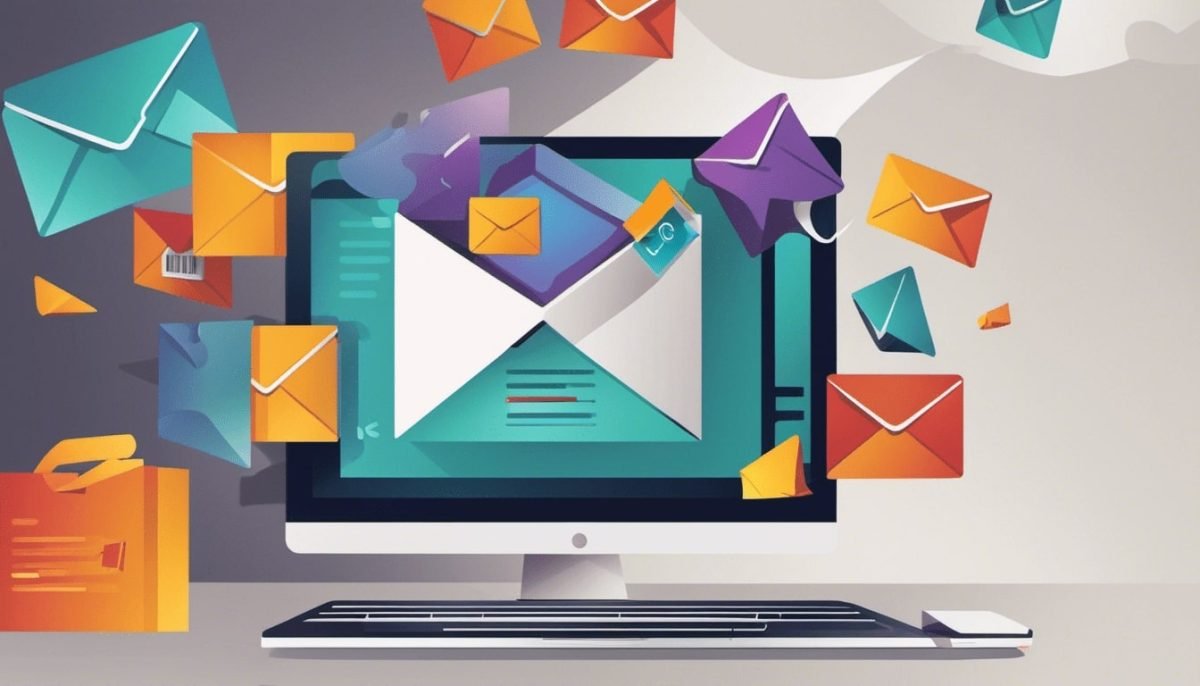Table of Contents
Today, the ability to connect with your audience has become a powerful weapon for those seeking to stand out in the vast sea of online marketing. The intelligent use of technology to optimize user engagement has become increasingly crucial, and this is where email marketing automation takes center stage in this challenge.
Get with just one click:
- Captivating content that grabs your audience’s attention
- Unmatched creativity for emotionally engaging content
- Trend-savvy copy to climb the search rankings
In a world where attention has become a precious commodity and personalization is the key to engagement, automating email marketing campaigns stands as the beacon guiding the path toward more effective and results-oriented communication.
Throughout this article, we will explore the meaning and importance of email marketing automation. We’ll discover how this strategy not only streamlines workflows but revolutionizes interaction with the audience, offering relevant and personalized content automatically.
A journey through the foundations, techniques, and best practices of email marketing automation that will provide you with the keys to understanding and effectively implementing this powerful strategy.
Let’s embark on this journey into the dynamic and increasingly relevant world of email marketing automation, discovering how this tool can radically transform your online communication strategy and take your brand to new levels of engagement and success.
Advantages and Benefits of Email Marketing Automation

Imagine reaching your audience with targeted messages that not only capture attention but offer relevant content precisely at the right moment. This is the revolutionary potential of email marketing automation.
Email marketing automation represents an automated process aimed at facilitating marketing campaigns conducted via email. This system utilizes specific software and tools to create, schedule, and send messages via email automatically, responding to certain triggers or predetermined conditions. The primary goal is to make communication with the audience more efficient and targeted, allowing for the automatic delivery of personalized and relevant content, thereby enhancing engagement and conversion.
Undoubtedly, the use of email marketing automation emerges as a valuable resource, offering a wide range of benefits capable of significantly shaping communication and marketing strategies.
Through in-depth analysis, we’ve identified and synthesized the primary advantages resulting from the adoption of this advanced technology. Here, we elaborate on the key benefits arising from the use of email marketing automation:
- Enhanced Efficiency and Time Savings. First and foremost, email marketing automation saves valuable time. Traditionally, sending mass emails required a significant investment of time and human resources. However, with automation, it’s possible to schedule the automatic sending of emails, thus saving hours of manual work and enabling a focus on other crucial business activities.
- Personalization and Audience Segmentation. Secondly, email marketing automation offers greater personalization and audience segmentation. Through automation tools, it’s possible to create and manage contact lists based on user behaviors, interests, or demographic data. This enables the sending of highly targeted messages, enhancing the effectiveness of marketing campaigns and improving the overall experience of email recipients.
- Increased Engagement and Conversions. Additionally, email marketing automation allows for setting up a predefined communication path for new subscribers. This means that after subscribing to the email list, users will automatically receive a series of welcome emails or sequential communications that can be used to engage them, introduce the company, or promote specific products or services. This initial phase is crucial for creating a positive impression and establishing a good relationship with new users.
- Campaign Optimization through Data Analysis. Finally, email marketing automation enables the easy monitoring and analysis of campaign results. Through reporting and analysis tools, detailed insights on open rates, click-through rates, and conversions can be obtained. These data aid in evaluating the effectiveness of email marketing automation strategies, identifying strengths and areas for improvement, and modifying ongoing campaigns to maximize results.
In summary, this tool proves fundamental for companies aiming to effectively reach their target audience and maximize the success of their email marketing automation strategies.
Audience Segmentation: More Than Just an Advantage
Segmentation of the audience is like a magical key in email marketing automation: it allows you to unlock the door for a deeper and more meaningful connection with your audience. It’s the beating heart of marketing strategies that enable a tailor-made experience for your readers.
Imagine personalizing every single email to make it seem as if it was written specifically for each person on your list. This is precisely what segmentation allows you to do: divide your audience into groups based on similar characteristics such as age, interests, purchasing behaviors, and geographic location. This division gives you the power to send targeted, pertinent, and relevant messages to each group.
Indeed, it’s not just about sending another email. This is a subtle yet powerful practice that allows you to maximize the impact of your campaigns, ensuring that your marketing efforts are not wasted. When you better understand your audience, you can focus your resources on people who are more likely to be engaged and interested in your offers.
Segmentation isn’t merely an abstract idea but requires a strategic approach. Let’s explore the phases involved:
- Collecting Detailed Data: Begin by gathering detailed information about your audience using sources such as demographic and behavioral data These data can include age, gender, geographic location, purchasing preferences, online behaviors, etc.
- Defining Segmentation Criteria: Based on the collected data, identify relevant segmentation criteria for your industry and marketing goals For instance, consider segmentation based on age, product preferences, income, online behavior, or a combination of these factors.
- Creating Homogeneous Segments: Group the audience into homogeneous segments, meaning groups with similar characteristics within each segment but significant differences among the various segments. For example, you might have a segment for tech-savvy young adults and another for seniors interested in travel and leisure.
- Utilizing Technological Tools: Using software and data analysis tools can facilitate the segmentation process. These tools can help identify patterns and relationships between data, simplifying the creation of more effective segments. Try discovering some by reading our article on the most important automation platforms, where we listed the characteristics and qualities of the most popular marketing automation platforms in the market.
- Customizing Communication and Marketing: Once the segments are defined, personalize messages and marketing strategies for each group. Ensure the message is relevant and suitable for the needs and preferences of each segment.
- Monitoring and Updating: Audience segmentation is not static. It’s important to constantly monitor campaign data and results to make changes and adaptations based on audience evolution and market needs.
Why is this practice so crucial in email marketing? Well, the answer is quite simple yet powerful.
Segmentation allows you to customize your email marketing strategies, maximizing the efficiency of your resources, enhancing conversions, and customer loyalty. It’s like offering a tailored suit to each reader rather than one size fits all. It’s a way to adapt, evolve, and thrive in a constantly changing world.
Segmenting the audience is not just a practice in marketing; it’s the key that opens the door to stronger and longer-lasting relationships with your audience. When you truly understand the people behind the email addresses, you can build a more authentic and deeper connection with them. It’s the difference between merely sending emails and genuinely communicating with the heart of your audience.
Shaping an Automated Workflow

Creating an automated workflow is an essential step to optimize efficiency and productivity across a wide range of sectors. This process requires a structured and well-planned approach. It consists of a series of fundamental strategic steps that, if followed carefully, can lead to significant results. Embarking on this journey requires a deep understanding of the involved processes as well as mastery of specific tools and resources.
It’s a process that demands detailed planning, thoughtful assessment, and a constant commitment to refining the system.
We’ve identified the steps to follow in establishing an efficient and adaptable automated process capable of streamlining operations and maximizing company productivity.
Let’s look at them below:
Identification of Processes to Automate
This crucial step allows the identification of areas where automation can be most effectively introduced.
Identify processes within your business that involve repetition, have clear phases, and can benefit from automation. These might be marketing processes, sales, human resource management, or other operational aspects. Automating human resources can aid in recruiting candidates more swiftly, while marketing automation can personalize communications with customers based on their behavior.
Defining SMART Objectives and Involving the Entire Team
Subsequently, it’s vital to establish clear and defined objectives to be achieved through automation. These objectives serve as a guide in decision-making, helping to determine which tools, software, or technological solutions are needed to support the workflow.
Set specific, measurable, attainable, relevant, and time-bound goals. For instance, the goal could be to reduce abandoned carts by 15% or increase efficiency in the recruitment process.
Communicate clearly with all team members involved in the process, ensuring everyone understands their role in implementation and how it could enhance their activity and the company’s performance in achieving the objectives.
Workflow Creation
Utilize automation tools, such as the email marketing automation functionalities offered by various platforms, to design the workflow graphically or through drag-and-drop features. Define triggers and actions that need to be executed in response to these triggers.
Once goals are identified and automation criteria are defined, the next step involves selecting and implementing the appropriate tools. This could involve adopting specialized software, developing custom scripts, or integrating dedicated platforms. Carefully evaluating available options and choosing solutions that align with the company’s needs are crucial for the success of the process.
Testing, Optimization, and Evaluation
Experiment with different solutions until you find the optimal workflow for your objectives. Continuously monitor the results and make changes based on analyses to enhance the process’s efficiency.
Regularly assess the results obtained through automation. Analyze the data to understand what works and what doesn’t, and make any necessary adjustments based on the workflow’s performance.
Ultimately, to ensure an efficient and continuously optimized automated workflow, it’s essential to consistently monitor and evaluate the system’s performance. This involves data collection, analyzing the outcomes, and making any improvements or adjustments necessary to ensure smooth execution.
We recommend reading our in-depth article where we detailed the 10 steps to follow for creating an effective email marketing automation campaign.
Common Pitfalls to Avoid
Just as in any activity, there’s the risk of making mistakes in email marketing automation. For the errors to avoid in email marketing automation, we suggest reading our article where we delved into the topic and here is the link.
Conclusions
The implementation of email marketing automation stands as a significant evolution in how companies conceive and execute their communication and marketing strategies. Throughout this journey through the intricate nuances of email delivery automation, we shed light on the tangible benefits and extraordinary potential this strategy offers.
It’s evident that automation isn’t merely a convenient option but a crucial cornerstone for optimizing email marketing campaigns. The ability to automatically send targeted and personalized messages in response to specific behaviors or triggers is the most effective means to maximize engagement and conversions.
Accurate audience segmentation, detailed data analysis, and constant optimization are the pillars on which automation’s effectiveness rests. These elements not only contribute to enhancing the overall customer experience but also generate measurable and tangible results.
Looking to the future, the effective implementation of email marketing automation not only stands as a key element for companies’ success but also represents a step towards a more personalized and engaging experience for recipients.